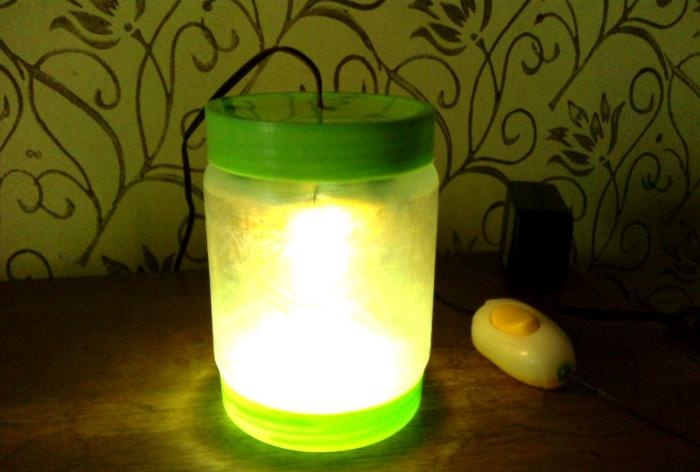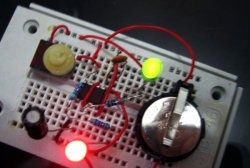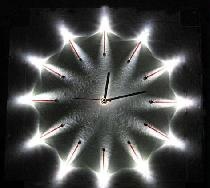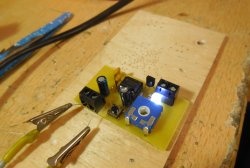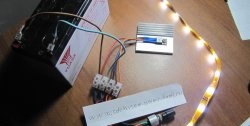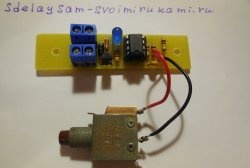This article will discuss one of the most common uses of the NE555 - a dimmer for adjusting brightness LEDs, which can be adapted as a homemade night light.
Part 1. Electronics.
The device diagram is presented below:
You can take any diodes VD1 and VD2, for example 1N4148. R1 adjusts brightness LEDs VD3-VD9. A variable resistor can be used combined with a switch; this option will look good in the style of old kerosene lamps, in which the brightness of the flame was controlled by a special handle. If you do not plan to change the brightness of the lamp, then any trimming resistor set to a suitable value will do.Capacitor C3 may be of a lower value, or it may not be there at all - the circuit will still start, but in this case the dimmer will make a barely audible squeak.
Board assembly:
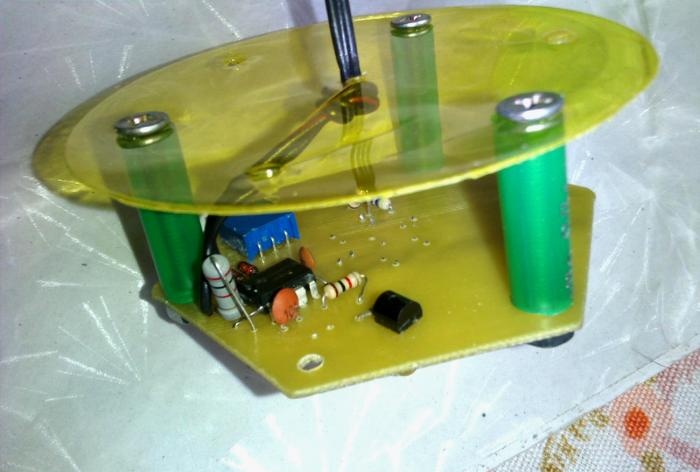

LEDs divided into two groups of 4 and 3 LED. Of course, there may be more or less of them, but you need to remember that depending on the quantity and power LEDs The choice of transistor VT1 depends. For a small number of low-power LEDs, like mine, any NPN transistor is suitable, even KT315 or its foreign analogues. For a more “gluttonous” load (for example, LED strip and high-power LEDs), it is better to choose a transistor like EB13005, which can be found in any energy-saving lamp, or the widely used field-effect transistor IRFZ44N.
NE555 has a wide supply voltage range, so you can use any suitable power supply (for example, from a laptop) or a phone charger for the circuit. It is not recommended to power the dimmer from batteries or rechargeable batteries, since the LED switching circuit with limiting resistors does not imply a sufficiently high efficiency, and the power source will quickly discharge.
The number of LEDs and the resistance of their current-limiting resistors will depend on the voltage. If you know how it is calculated, feel free to move on to the next part, if not, spend a couple of minutes reading the quick guide.
So, the resistance is calculated by the formula:
R = Upit – Usv / Isv, where
R – resistance of the current-limiting resistor;
Upit – circuit supply voltage;
Usv – voltage drop across the LED;
Isv – LED supply current.
The values of Ulight and Ilight vary depending on the color and power of the LEDs; it should be clarified in the documentation for the specific model.If there is no documentation (which is the norm for the vast majority of Chinese products), then you can use the average values from the table:
Color and type | LED voltage drop (volts) | LED supply current (amps) |
Red 5 mm. | 1.8-2.1 | 0.02 |
Yellow 5 mm. | 1.9-2.3 | 0.02 |
Blue 5 mm. | 2.5-3.5 | 0.02 |
Green 5 mm. | 2.5-3.5 | 0.02 |
White 5 mm. | 2.5-3.5 | 0.02, 0.05-0.07** |
White 1 W* | 3.2-3.4 | 0.3 |
White 3 W* | 3.2-3.4 | 0.7 |
* For LEDs 1 Watt or more, a heatsink is required for cooling.
**A current of 0.05-0.07A is required for super bright white LEDs.
The parameters presented in the table are approximate. For example, for 5 mm LEDs, the supply current can vary in a fairly wide range - from 5 to 35 mA, however, at the minimum value they will glow dimly, and at the maximum value they will quickly overheat and fail.
Now let's use the above formula and calculate the resistor resistance for a chain of four LEDs connected in series: three yellow and one white. Let the circuit supply voltage be 12 volts.
First, we find out the voltage drop across the entire chain using the formula
Usv = U1 + U2 + ... + Un, where
U1, U2, Un – drop voltage on each LED of the chain.
Usv = 1.9 + 1.9 + 1.9 + 2.5 = 8.2 volts.
The current does not change during a series connection, that is, on all elements of the circuit its value will be equal to 0.02 A.
Let's move on to calculating the resistance:
R = 12 – 8.2 / 0.02 = 3.8 / 0.02 = 190 Ohm.
We select a resistor from the standard line that is close to the result obtained - 200 Ohms.
At the same time, it would be nice to calculate the minimum power of the resistor:
P = (Upit – Usv) * Isv
P = (12 – 8.2) * 0.02 = 3.8 * 0.02 = 0.076 W
The closest in power is 0.125 W, but you can choose with a margin of 0.25 W.
The resistor can be of higher resistance (within reasonable limits). When assembling the circuit, I did not find a 300 Ohm resistor and replaced it with a 470 Ohm one, limiting the current to 0.015 A. Due to the fact that the current/brightness ratio of LEDs is non-linear, such a replacement did not greatly affect the final result.
Now you know how to independently calculate denominations that suit your needs. By combining different colors, you can get beautiful combinations and shades that will make the night light more “magical”. Thus, the combination of orange and warm white gives a pleasant peach color, and yellow and green create a soft “green lawn” color.
Part 2. Appearance.
As you know, the assembled and working board is only half of the device. Design is no less important, and problems often arise with it. It’s good if you have a suitable case from some Chinese night light for $1, but if not, don’t despair, simple and original solutions can be found in the most unexpected places. For example, in the bathroom.So, we will need:
1. Empty plastic jar (for example, from hair conditioner) – 1 pc.
2. Lids from this and another similar jar - 2 pcs.
3. Matte self-adhesive with a pattern.
4. A piece of sandpaper.
5. Nail polish remover or acetone.

1. Free the jar from the glued paper. Using nail polish remover, remove any remaining glue. Don't forget to ventilate the room well! After getting rid of the glue, wash the jar with warm water and soap and dry it.
2. Using fine sandpaper, matte the surface of the jar. Cut a piece of self-adhesive to a suitable length and width and glue it around the circumference of the jar.Choose a pattern that will diffuse the light well and beautifully.
3. Now glue one lid to the bottom of the jar - this will be the “bottom” of the lamp. You can pre-paint the lids from a spray can, or you can leave them as is - then they will be illuminated by LEDs, creating an additional effect.
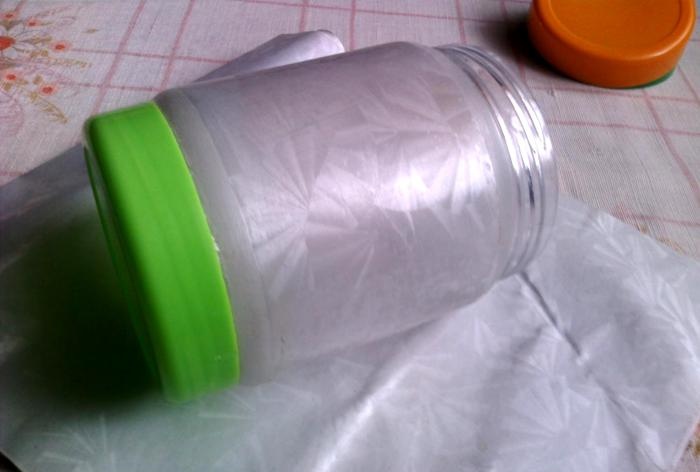
4. In the second cover, drill a hole for the power wire (and, if necessary, for a variable resistor). Their location depends on the chosen design: in a pendant lamp, it is better to place the hole for the wire in the center of the cover, in a table lamp - on the side. In addition, in the desktop version, it is more convenient to place the board at the bottom of the lamp, that is, the glued “bottom” will be on top, and the screwed-on cover with the board inside will be on the bottom, since a wire lying inconspicuously on the table looks more aesthetically pleasing than one hanging from somewhere above. We pass the wire through the hole and solder it to the board. Don’t forget also about the connector for connecting to the power supply and the switch; they can be made hinged. The board itself can be secured to the back of the cover with silicone glue.
download board
5. Screw on the top cover.
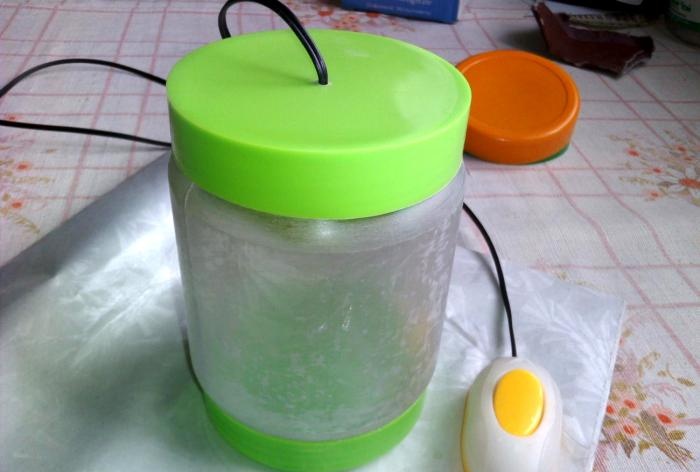
All that remains is to build some kind of mount if you plan to make the night light hanging.
The lamp is ready!
